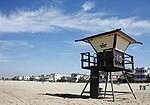Surfside, California

Surfside (or Surfside Colony) is a small gated community with three rows of houses, lettered A, B, and C. Surfside is part of the city of Seal Beach, California and is located on the west side of Pacific Coast Highway, southwest of the Naval Weapons Station Seal Beach between the station and the Huntington Beach community of Sunset Beach. It is also near the Huntington Beach community of Huntington Harbour. The southern entrance to the Surfside Colony is easy to spot by the water tower (which was built into a house) that can be seen from Pacific Coast Highway. The Surfside Colony is served by the Surfside Colony Community Services Tax District and the Surfside Colony Storm Water Protection Tax District. Lifeguard services are provided by the city of Seal Beach.
Excerpt from the Wikipedia article Surfside, California (License: CC BY-SA 3.0, Authors, Images).Surfside, California
Phillips Street,
Geographical coordinates (GPS) Address Nearby Places Show on map
Geographical coordinates (GPS)
| Latitude | Longitude |
|---|---|
| N 33.728888888889 ° | E -118.08388888889 ° |
Address
Phillips Street 168
90742
California, United States
Open on Google Maps









